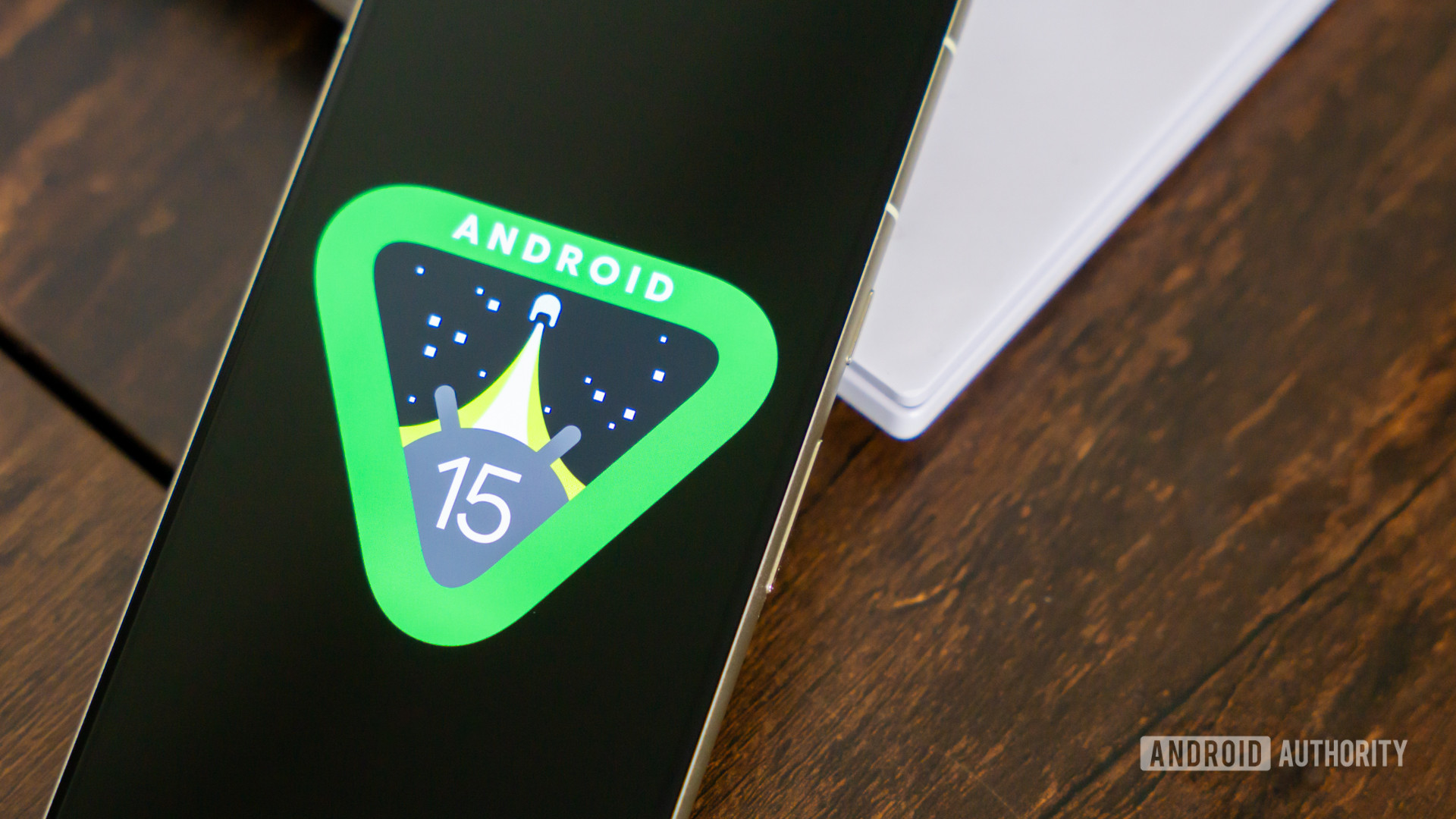Android 14 was publicly launched with the Pixel 8 series back in October 2023. We’re a few months into the new year, and Google has begun testing the next version of Android, now up to the second Android 15 Developer Preview. This is still only intended for developer use, but things are coming along. Still, it gives us a good look at what to expect in the next major release to the Android platform.
Android 15: Name and release date
Google used to name Android versions with dessert codenames, but it strayed away from that tradition with the release of Android 10, where it decided to stick with only the version number for all future releases. So Android 15 is simply known as Android 15. However, Google still uses the dessert codenames internally. Android 15’s internal codename is Vanilla Ice Cream.
Google has begun testing Android 15 through Developer Previews, though the final stable release is still several months away. Android 15’s release schedule includes developer previews running through mid-March, followed by beta releases up to May. Android 15 will reach platform stability in June-July, meaning that no new features or APIs will be added to the platform so that app developers can begin testing their apps against these public APIs. The next few releases will be focused on ironing out bugs.
Google hasn’t mentioned when the stable Android 15 builds will be released, but we presume it will happen alongside the Pixel 9 series launch, possibly in October 2024.
If you use a recent Google Pixel device, you will be the first in line to receive the Android 15 update. OEMs will take a little longer to release their functional Android UX skins on top of the Android 15 platform. We are likely to see developer preview builds surface in the coming months for select phones. For those who don’t mind taking matters into their own hands, you can follow our guide and install Android 15 on your phone by yourself.
Once Android 15 is released publicly, OEMs will run their own beta programs for their skins, followed by stable releases. You can check if your phone has received the update through our Android 15 update tracker.
Android 15: New UI changes, features, and UX improvements
Android 15 looks quite similar to previous Android versions, but there are some notable changes that Google has introduced with this update. There are also functionality updates to several important features. All of these features have either been officially announced or have been spotted in the released Android 15 build.
Partial screen sharing
With Android 15, users can share or record just an app window rather than the entire device screen. This feature was enabled first in Android 14 QPR 2 on Pixel devices but will now be available across the wider Android platform.
Satellite connectivity support
Android 15 extends platform support for satellite connectivity. The platform now has UI elements that are needed to “ensure a consistent user experience across the satellite connectivity landscape.” As part of these changes, apps can use APIs that allow them to detect when a device is connected to a satellite, which can give the app more awareness of why full network services are unavailable.
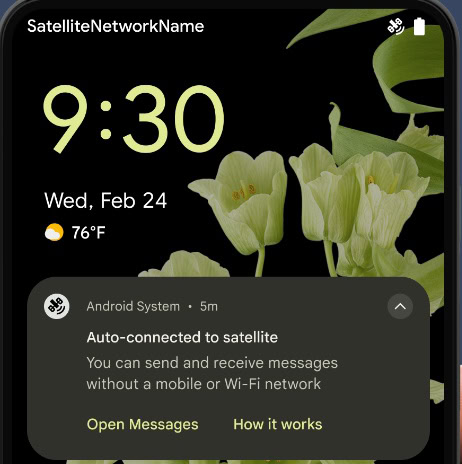
Android 15 also provides support for SMS apps and preloaded RCS apps to use satellite connectivity for sending and receiving messages. This means that satellite connectivity will not be limited to emergency uses only. Leaks had indicated that a deeper T-Mobile tie-in would be in place for satellite connectivity features, but Google has not yet revealed such details. You can read about this deeper T-Mobile tie-in later in this article.
Notification cooldown
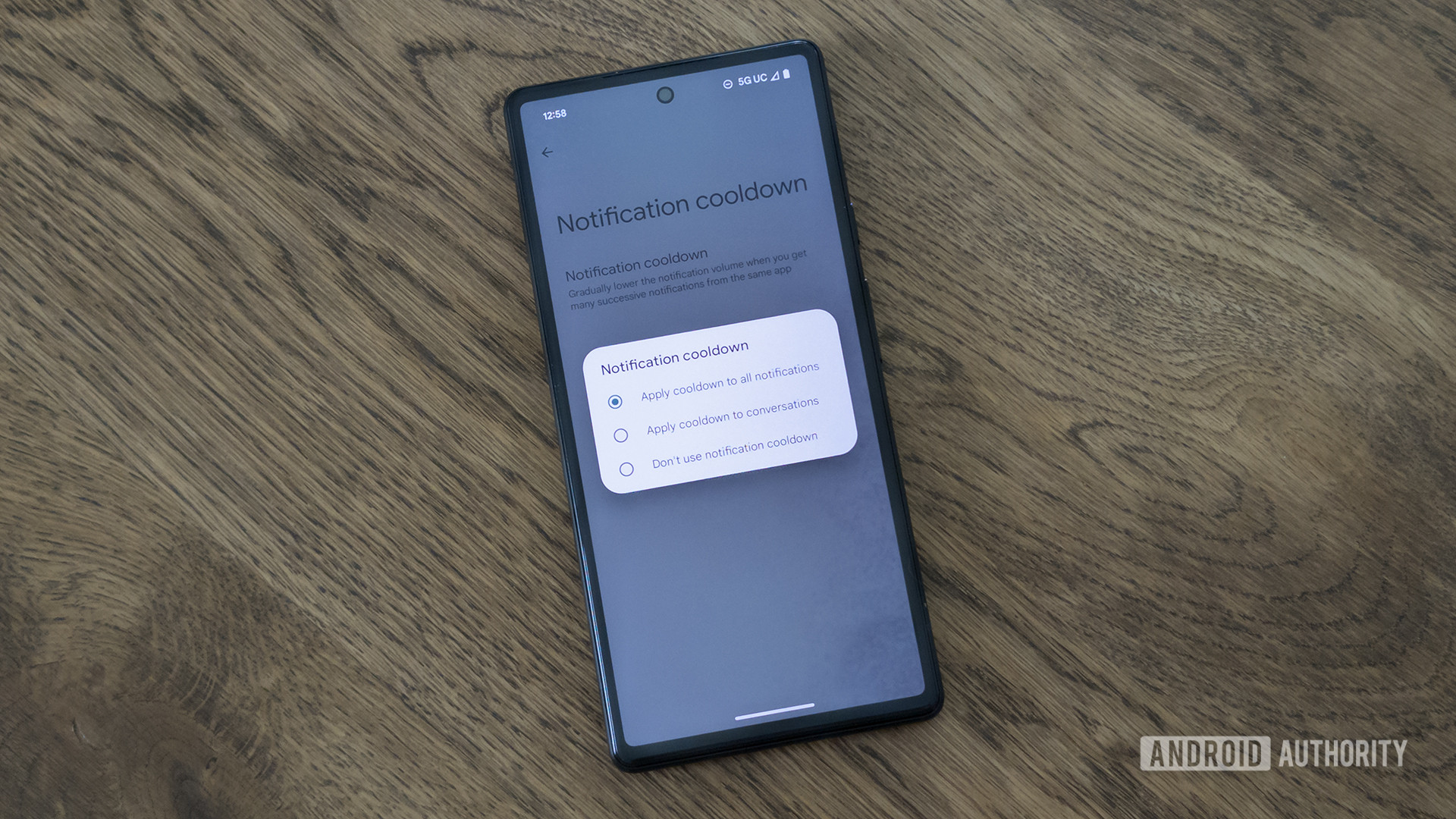
C. Scott Brown / Android Authority
There’s a new function that can be found within the Notifications section. This function is called “Notification cooldown,” and it lowers the volume of successive notifications that come from the same app. It’s designed to prevent users from being overwhelmed by too many notifications.
New in-app camera controls
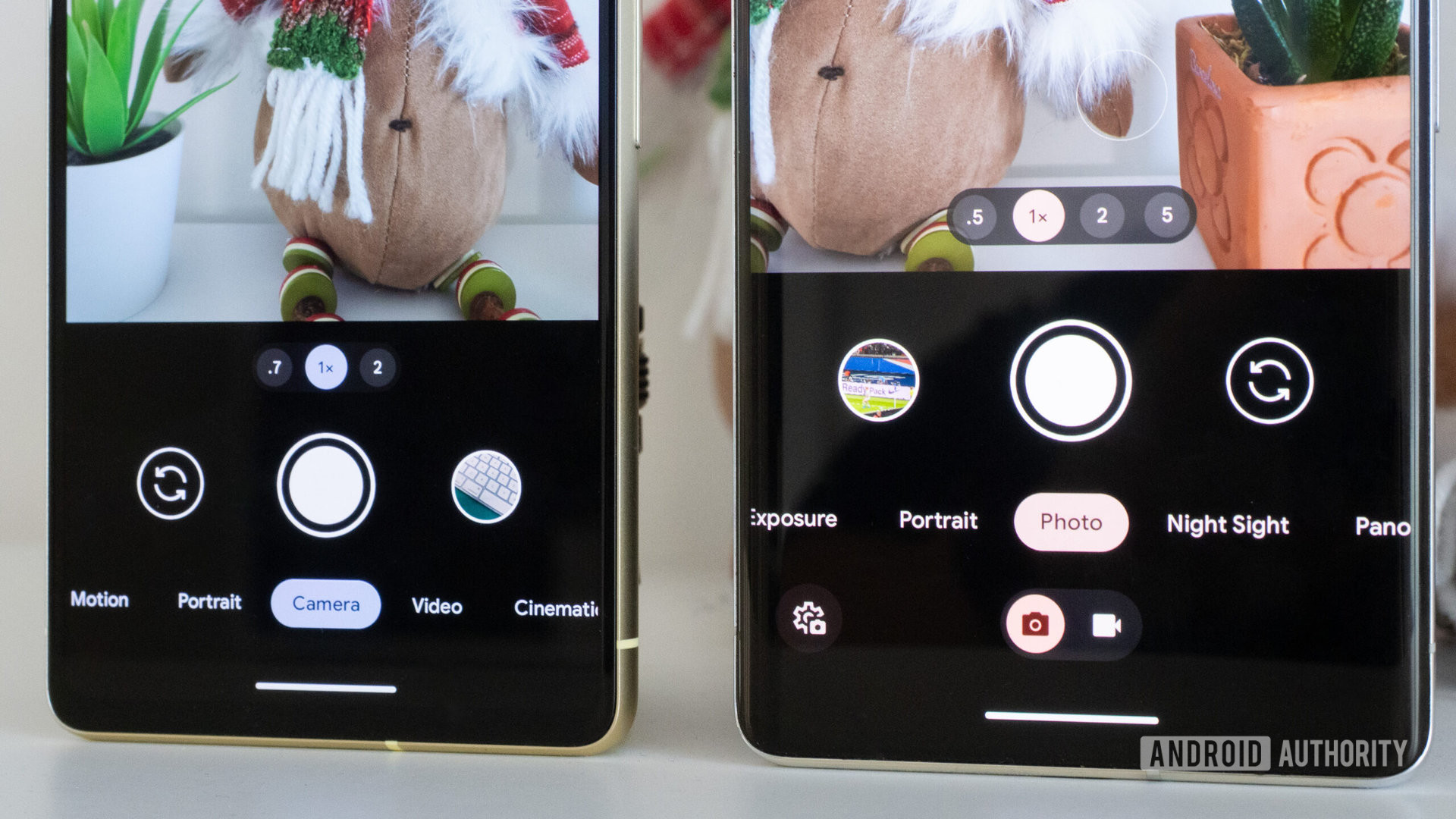
Rita El Khoury / Android Authority
Android 15 is adding new extensions for more control over the camera hardware on supported devices. New features added through these extensions include low light enhancements that give developers control to boost the brightness of the camera preview and advanced flash strength adjustments that enable precise control of flash intensity when capturing photos.
Universal toggle for keyboard vibration control
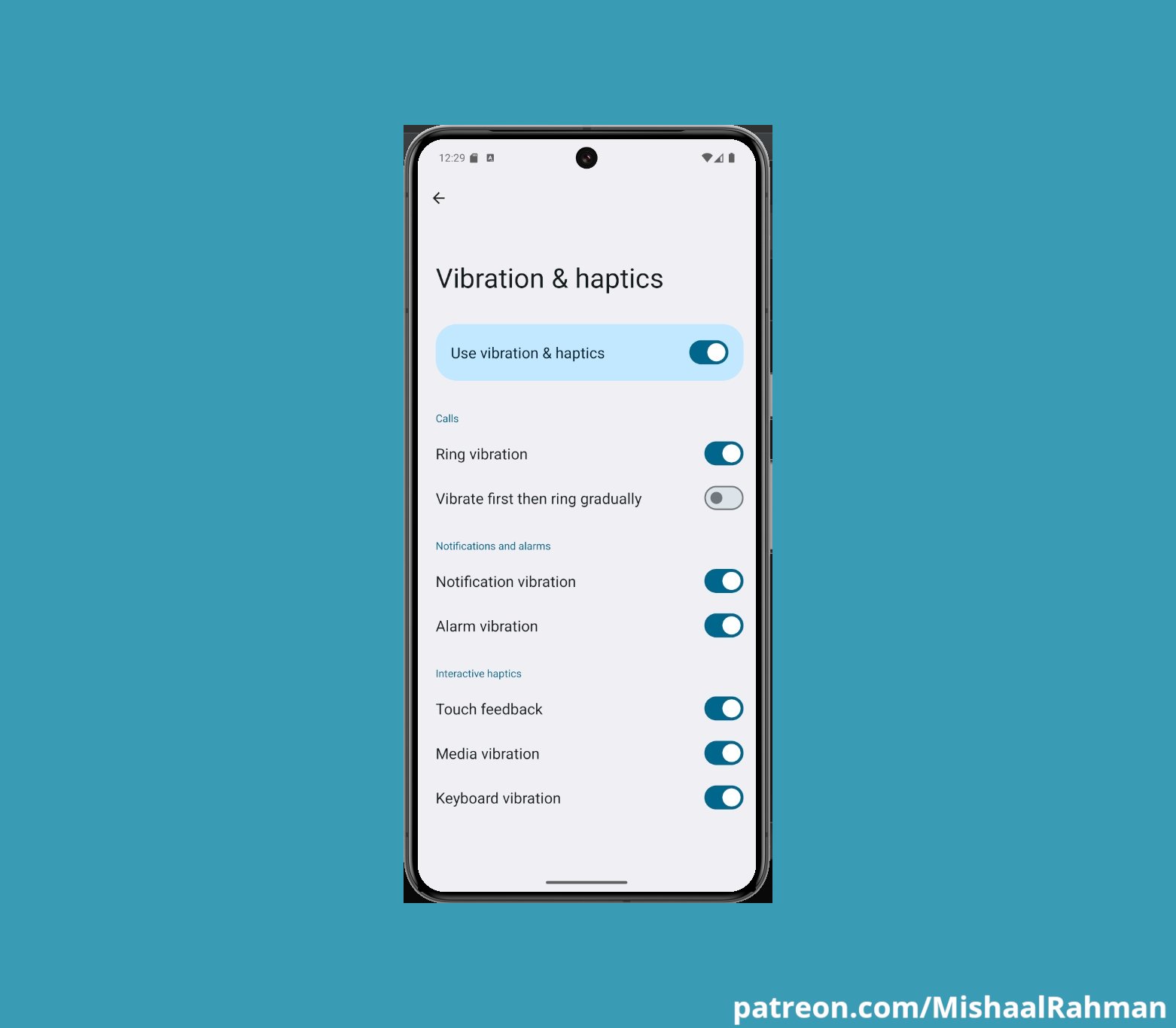
Android 15 Developer Preview 1 added a new “keyboard vibration” toggle that lets you universally disable keyboard vibration. When turned off, the system setting will override the setting within individual keyboard apps. When turned on, you can control the setting within individual keyboard apps, too.
Sensitive Notifications
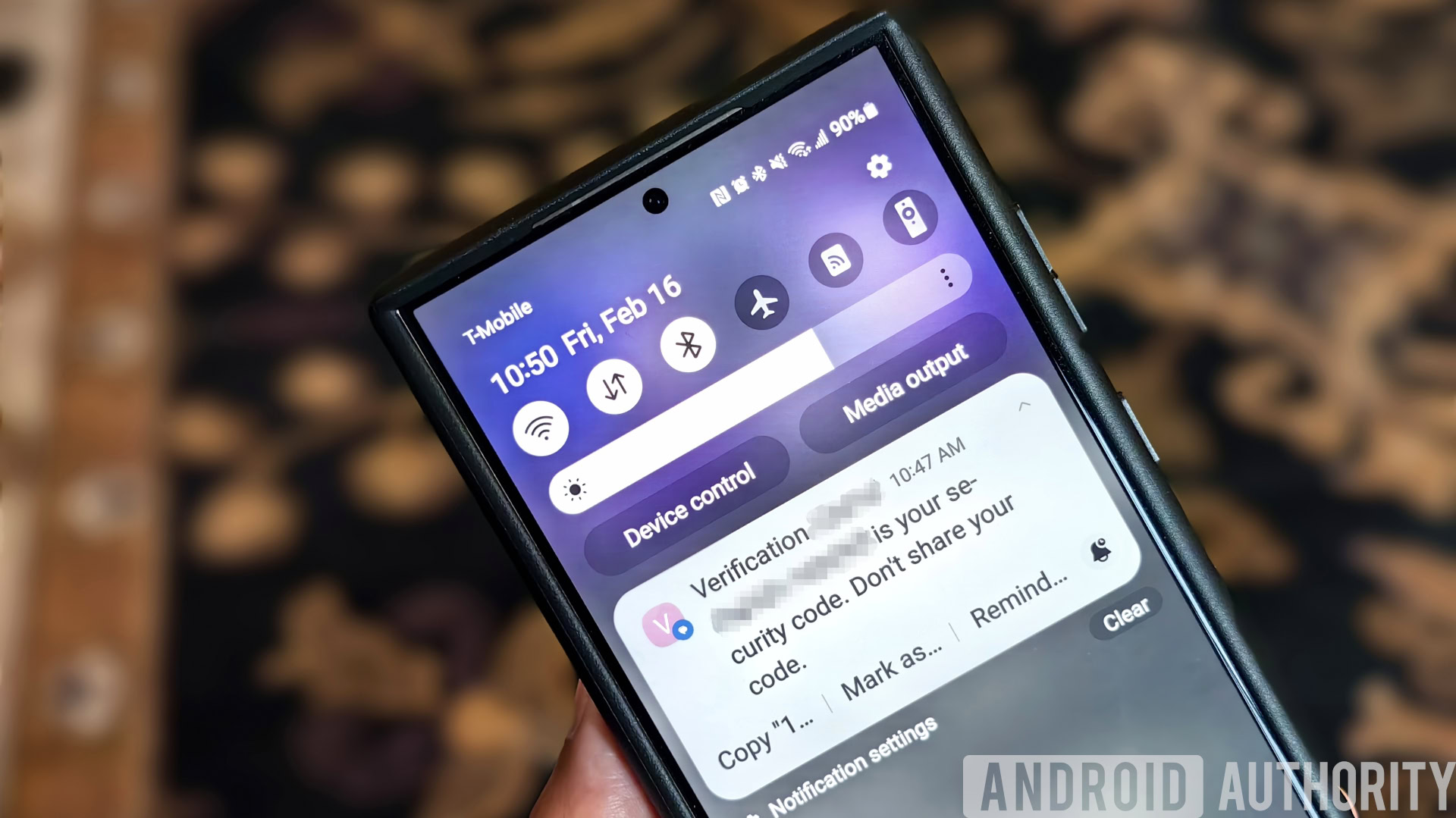
Mishaal Rahman / Android Authority
Some forms of two-factor authentication (2FA) are safer than others, but many platforms rely on the most basic form of 2FA that sends one-time passwords (OTP) via text or email. However, Android 15 will fix that by adding a sensitive notifications feature that prevents your OTPs from being read by malicious Android apps.
Bluetooth popup dialog
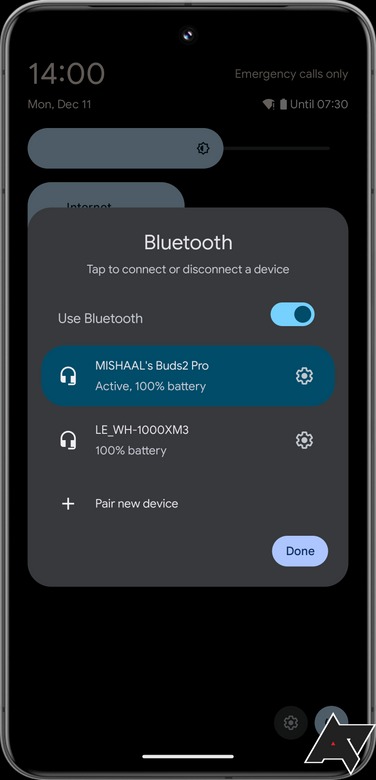
Android lets you toggle Bluetooth through the Quick Settings tile, but most people leave the connection on to quickly connect to their accessories throughout the day. If you have multiple accessories around, you may find better utility with a Quick Setting tile that lets you toggle the individual connections to connect and disconnect to individual devices.
Android 15 brings this functionality, letting you click on the Bluetooth Quick Settings tile to open up a popup dialog that lets you perform more functions, such as toggling Bluetooth, connecting and disconnecting to individual devices, entering their settings page, and pairing new devices.
Auracast focus: Audio sharing to nearby Bluetooth LE Audio streams
Android 13 lets users share or connect to nearby LE Audio streams, but Android 15 could make the Auracast feature easier to discover. This would allow Auracast-supported devices to broadcast audio to nearby Auracast devices using BLE without the hassle of pairing. There is a new “audio sharing” page that appears at Settings > Connected devices > Connection preferences to facilitate this audio sharing, as spotted in Android 15 Developer Preview 2.
High-Quality Webcam mode
Third-party webcam apps make it easy to use your Android phone as a webcam for your PC. Android 14 QPR 1 release for Pixel smartphones integrated the feature into the system, meaning you didn’t need a third-party app anymore. However, the output quality was pretty mediocre.
Android 15 Developer Preview 2 integrates a new High-Quality Webcam mode when you start the USB webcam feature on a Pixel device.
There is a new “HQ” symbol in the webcam preview, tapping on which disables any power optimizations that Google made that previously resulted in lowered quality. This mode significantly improves video quality, but the drawback is increased battery drain and heat buildup.
Changes for continuity features on foldables
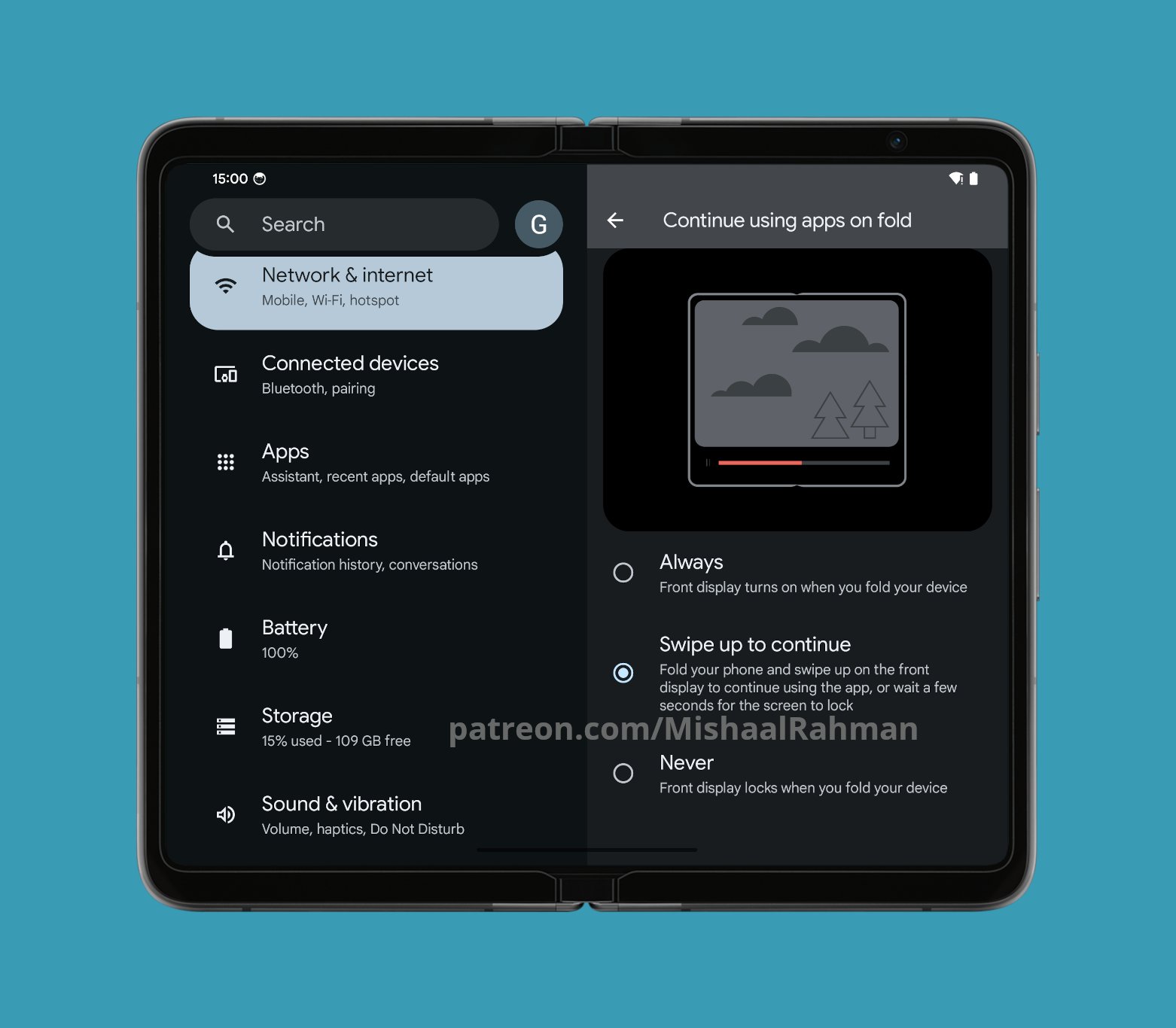
With Android 15, you can control whether you want to continue to use apps on the front display on foldables. Mishaal Rahman notes that this feature was present on Android 14 QPR betas but was removed and is now returning. You can either have the front display turn on whenever you fold your device; have it turn on for games, videos, and other apps, or never turn it on and lock the front display when you fold your device.
If these settings feel restrictive to you, Mishaal Rahman notes that Google is also testing a “swipe up to continue” option that replaces the “only games, videos, and more” option. This mode will let you continue apps on the cover screen by swiping up on the lock screen after you fold your device.
Better cover screen support
With Android 15, app developers can declare a property to allow their app to be presented on the small cover screens of supported flippable devices. These cover screens are often too small to run full-fledged apps with a good user experience, but app developers can opt-in to support these cover displays.
Persistent taskbar for large-screen devices
Google added a taskbar dock for large-screen devices with Android 12L. It took the entire width of the screen and stayed there persisently, but this meant it took up a lot of screen space rather permanently. With Android 13, the taskbar shrunk in size to a smaller pill-shaped box, but it also became transient, appearing for a few seconds only when the user swiped up on the gesture bar. While the change was good, it also made accessing the taskbar dock a two-step process, which may not work for heavy multi-taskers.
With Android 15 Developer Preview 2, Google is giving users the option to choose the transient taskbar or to make it permanent with a new “always show taskbar” toggle.
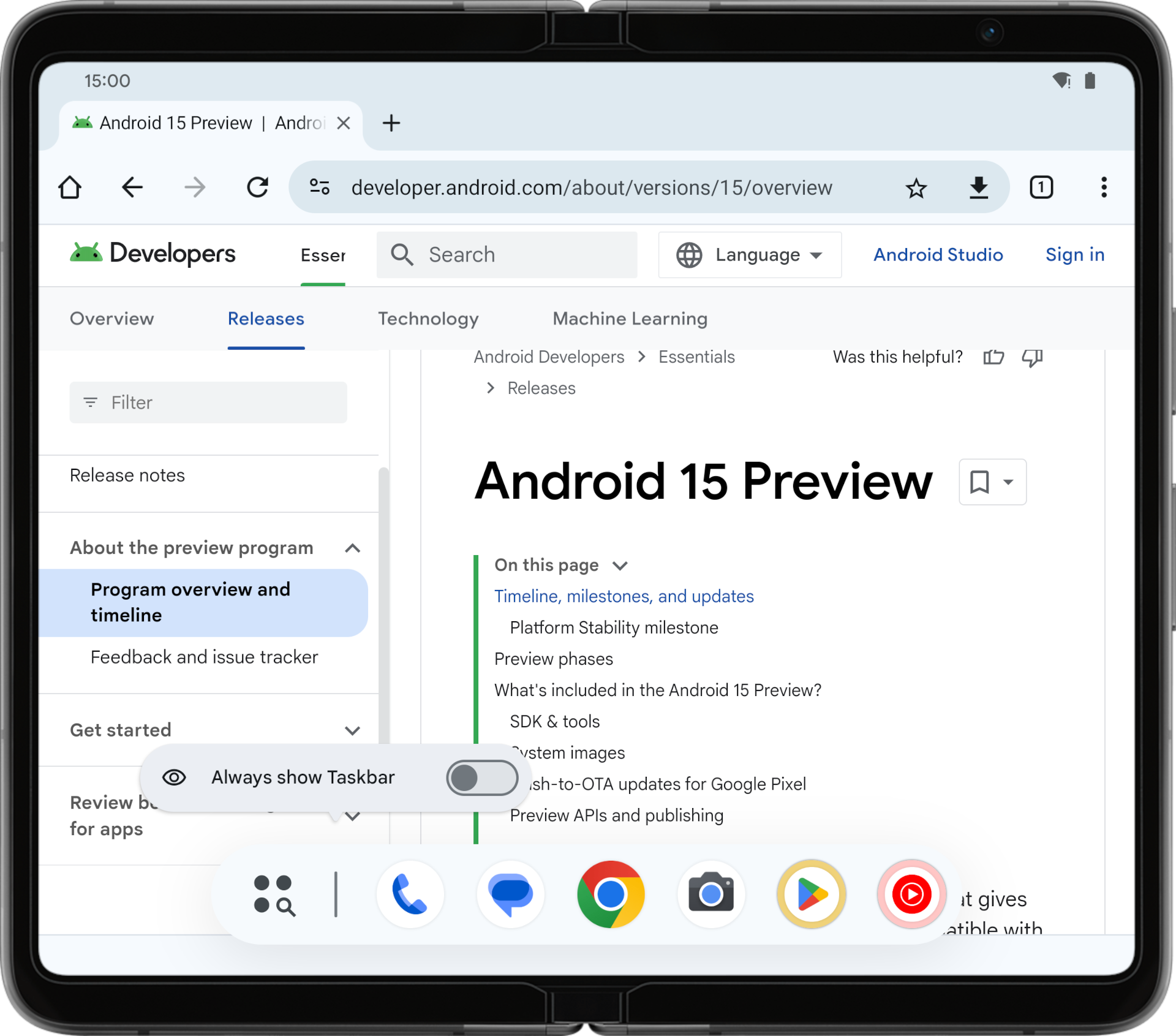
Mishaal Rahman / Android Authority
This way, users can have the best of both worlds, suiting their needs.
Health Connect
Android 15 includes updates to the Health Connect by Android platform, which adds support for new data types across fitness, nutrition, and more.
Virtual MIDI 2.0 Devices
Android 13 added support for connecting to MIDI 2.0 devices via USB, which communicate using Universal MIDI Packets (UMP). Android 15 extends UMP support to virtual MIDI apps. This enables composition apps to control synthesizer apps as a virtual MIDI 2.0 device, just like they would with a USB MIDI 2.0 device.
HDR headroom control
In situations where you have some HDR content on your screen but more SDR content (for example, an HDR thumbnail while the rest of the content is in SDR), the HDR content can overpower the perceived brightness of the rest of the SDR content. Android 15 allows apps to control the HDR headroom, so they can avoid such situations.
Loudness control
Android 15 has officially introduced support for the CTA-2075 loudness standard that helps app developers avoid loudness inconsistencies and ensures users don’t have to constantly adjust volume when switching between content. The Android system leverages known characteristics of the output devices (headphones, speaker) along with loudness metadata available in the AAC audio content to “intelligently adjust the audio loudness and dynamic range compression levels.”
Smaller changes
There are a few smaller changes as well that have been either announced by Google officially or spotted on Android 15 builds so far:
- There is haptic feedback when adjusting the display brightness through the Quick Settings slider (h/t Mishaal Rahman).
- New APIs allow smoother NFC experiences by allowing devices to listen but not respond to NFC readers. In some cases, this would allow for a one-tap transaction.
- Android has a new PDFRenderer API, allowing apps that use it to render password-protected PDF files, annotations, allow for form editing, searching, and selection with copy.
- The Pixel Launcher has a new “apps list settings” page that contains the “swipe to start search” settings toggle (h/t Mishaal Rahman).
- In the future, this page could also house a new “show long app names” setting that would let you display long app names on two lines in the search results and apps list.
- On the Google Pixel Fold, Android 15 Developer Preview 2 has added a “swipe up to continue” screen lock feature. This feature lets you transition all apps from the inner display to the outer display with a swipe up on the outer display when you fold shut your device.
- New accessibility settings for use with physical keyboards: You can enable Sticky keys, Slow keys, and Bounce keys when you are using a physical keyboard on a device with Android 15. This feature will be useful for users with motor disabilities and those who face difficulties typing on a physical keyboard.
- Sticky keys make it easier to enter keyboard shortcuts in quick succession.
- Slow keys hold down the duration that the user has to press before the system accepts a keypress.
- Bounce keys help ignore rapid, repeated presses of the same key.
- Android 15 also shows a preview of the keyboard layout that you select in physical keyboard settings, in case your physical keyboard has a different physical layout.
Android 15 performance improvements
Improvements to the Android Dynamic Performance Framework
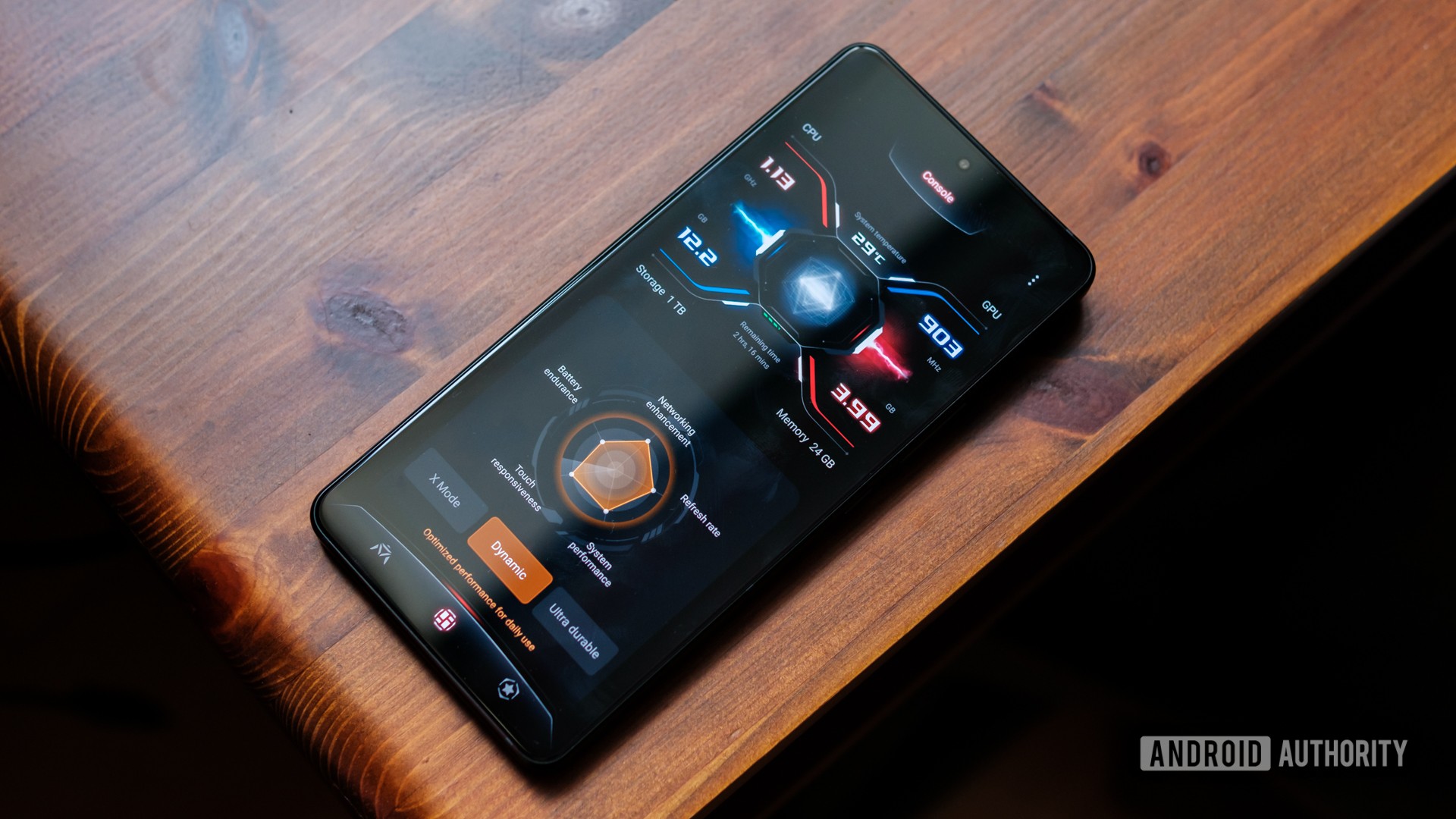
Robert Triggs / Android Authority
Android 15 continues work in the Android Dynamic Performance Framework (ADPF). ADPF is a set of APIs that allow games and performance-intensive apps to interact more directly with the power and thermal systems of Android devices. With these APIs, you can monitor system behavior better and then go a step further to optimize performance to a sustainable level that doesn’t overheat devices.
ADPF consists of these main features:
- Thermal-state monitoring
- CPU performance hints
- Fixed-performance mode
On supported devices, Android 15 will add new ADPF capabilities, namely:
- A power efficiency mode for hint sessions to indicate that their associated threads should prefer power saving over performance. This is said to be good for long-running background workloads.
- Hint sessions can now report CPU and GPU work durations, allowing the system to adjust CPU and GPU frequencies together to best meet workload demands.
- New thermal headroom thresholds to interpret possible thermal throttling status based on headroom prediction.
App and game developers can use these APIs to make their apps and games work better on devices that would support these APIs.
App archiving through Settings
iOS has a handy feature that lets you “offload apps” to reclaim some storage space. You can uninstall apps you use rarely but keep the user data around. So when you reinstall the app, you can get back where you had left off.
With Android 15 Developer Preview 2, Google has baked in a similar app archiving feature. The feature was announced back in 2022, but could finally see integration within the platform.
When an app is archived on Android, most of its working files will be removed, while a stripped-down version of the app will be retained. There will be a home screen icon which, when clicked, will trigger the Google Play Store to unarchive the app.
Google already lets you opt into auto-archiving through the Google Play Store. Since the feature is run through the Play Store, you cannot archive or unarchive apps through your phone’s Settings app.
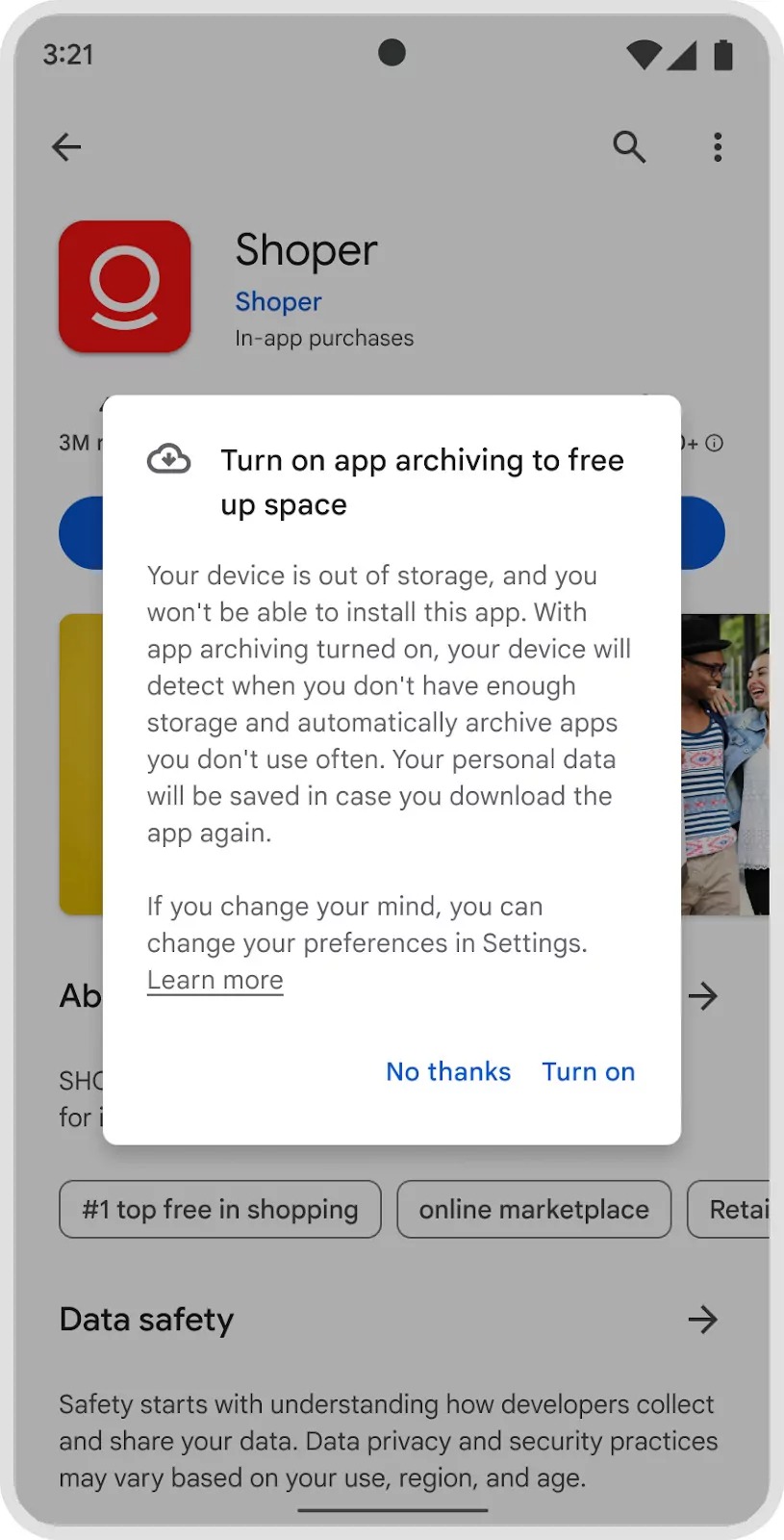
Mishaal Rahman / Android Authority
Android 15 changes this behavior by adding a new Archive and Restore button on the App Info page.
This way, even apps installed from outside of the Play Store could be archived from an easily accessible location.
In this demo, an app that is 387MB in size has been archived to just 18MB in size, which is a staggering 95% decrease. After the archive, the app was restored back to show how none of the user data was lost in the process.
Android 15 will not only let you manually archive apps but also let you choose whether to have the OS automatically archive apps that you do not use often. Further, other app stores beyond the Google Play Store will also be able to get the feature working if they support the necessary app formats.
Locking WebView into memory
Android 15 Developer Preview 1 is locking into memory the trichrome library that Android System WebView uses. Many apps use Android System WebView to display internet content, as it helps them avoid building a web browser from scratch for such a task. Since the process is locked into memory, the Android system will deprioritize killing the process during regular RAM management operations.
In theory, apps that rely on WebView could see a marginal improvement in their performance to the extent of their use of WebView, especially on devices with less RAM where processes are more frequently purged from RAM.
Smaller changes
- Android 15 has new APIs that allow apps to track their app startup and stop state, display their detailed app size information, and more.
- There is a new “disable default frame rate for games” setting in Developer Options that disables limiting the maximum frame rate for games at 60Hz.
Android 15 privacy and security features
Privacy Sandbox on Android
One of the highlights of the Android 15 update is that it incorporates the latest version of the Privacy Sandbox on Android.
Privacy Sandbox on Android is a multi-year initiative from Google that introduces more private advertising solutions that limit the sharing of user data with third parties and operate without cross-app identifiers. The goal here is to develop an effective and privacy-enhancing advertising solution where user information is protected. This is needed to cultivate a healthy app ecosystem, which is needed for the overall health of the Android platform.
File integrity
Android 15 introduces a new FileIntegrityManager API that uses a feature called “fs-verity” in the Linux kernel. With fs-verity, files can be protected by custom cryptographic signatures, ensuring that they do not get tampered with or corrupted. So app developers can rest easy knowing that their app functionality and data are not compromised in any way.
Screen record detection
Android 15 will allow apps to detect when they are being screen-recorded. For apps that perform sensitive operations, developers can invoke APIs to allow the content to be hidden within such screen recordings.
Smaller changes
- On Android 15, you now have to authenticate your identity using the fingerprint sensor or other lockscreen security options if you want to change the USB mode on your phone when it is connected to a computer.
Android 15: Leaked and upcoming features
In addition to all the features that Google has officially announced, and those that have been spotted in the Android 15 Developer Preview 1 build, there are plenty of changes that have been leaked and are rumored to arrive on Android 15.
Satellite Messaging with T-Mobile
There are clues in the Android 14 QPR3 Beta 2 release that indicate that Google is working on bringing satellite connectivity to Android smartphones, in conjunction with T-Mobile. The presence of this code in the Android 14 QPR3 Beta 2 release indicates that the feature could see a rollout to the stable branch with the release of Android 15.
This is what the Satellite Messaging page within Android 15 could look like:
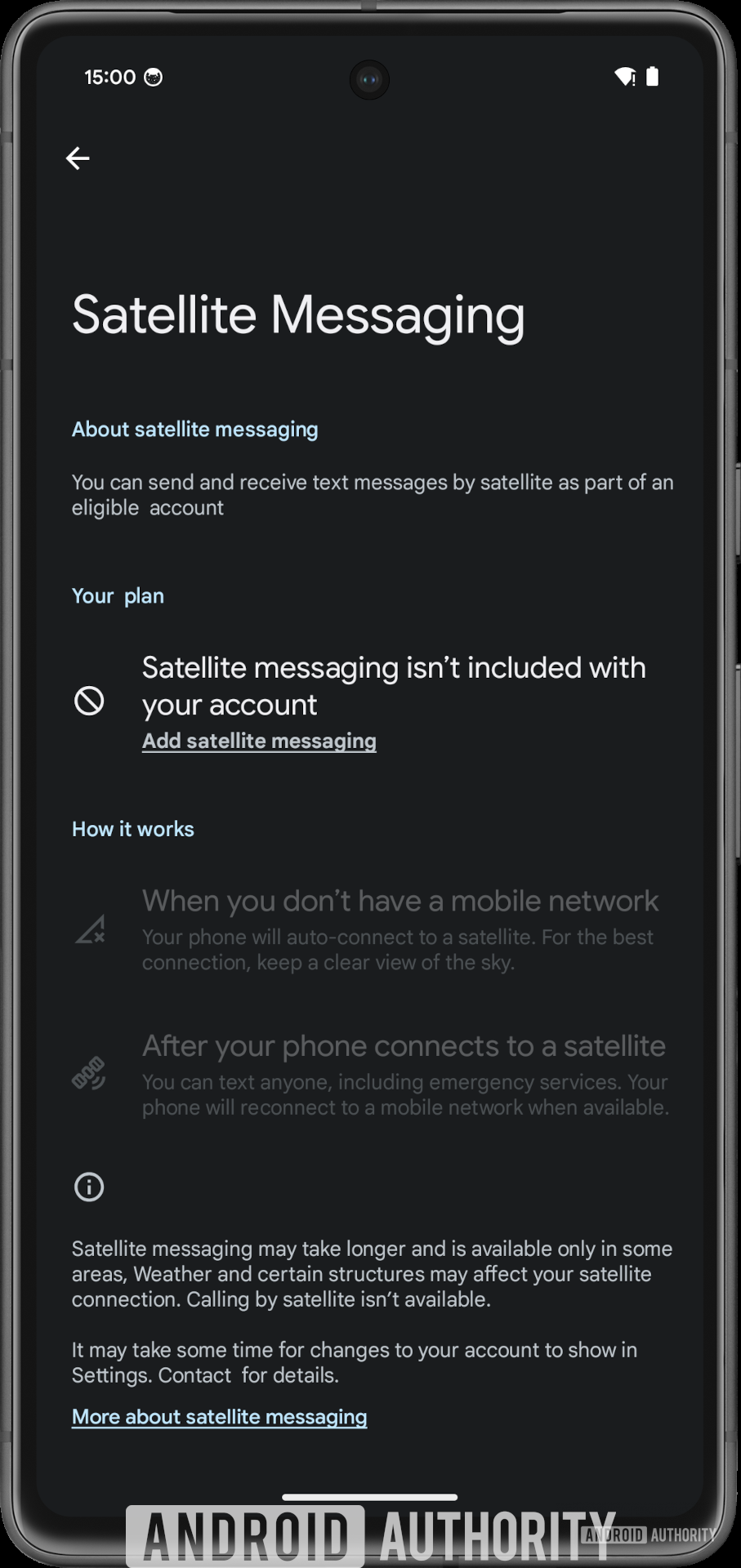
Mishaal Rahman / Android Authority
The satellite messaging provider is not immediately clear from the screenshot, but the buttons present on the screen lead to a T-Mobile satellite coverage page, suggesting that T-Mobile could be Android’s satellite messaging provider. In turn, T-Mobile is partnering with SpaceX for satellite-to-phone connectivity.
As we can see from the strings and the surfaced screenshot, when you add satellite messaging to your T-Mobile plan, you will be able to send and receive text messages to any account (and not just emergency services) when you are in an area with no cell service. You will need a clear view of the sky, and the connection could be impacted by weather and other structures. When you are in the range of a mobile network again, your phone will disconnect from the satellite and reconnect to cellular services again.
Google has announced satellite connectivity for the Android platform but has not yet revealed details about this T-Mobile centric-partnership. You can force invoke the above screen by invoking the android.settings.SATELLITE_SETTING Intent action in Android 15 Developer Preview 2.
Lockscreen widgets
Android supported lockscreen widgets with Android 4.2 Jelly Bean, but the feature was killed off in Android 5.0 Lollipop. Since iOS brought lockscreen widgets with iOS 16, Android could bring widgets back to the lockscreen with Android 15.
There are a few approaches Google could take to bring widgets back to the lockscreen with Android 15, so we recommend following the link for more details. Note that it is possible that Google could reserve lock screen widgets to certain devices, namely hub mode devices like the Pixel Tablet.
Battery health percentage
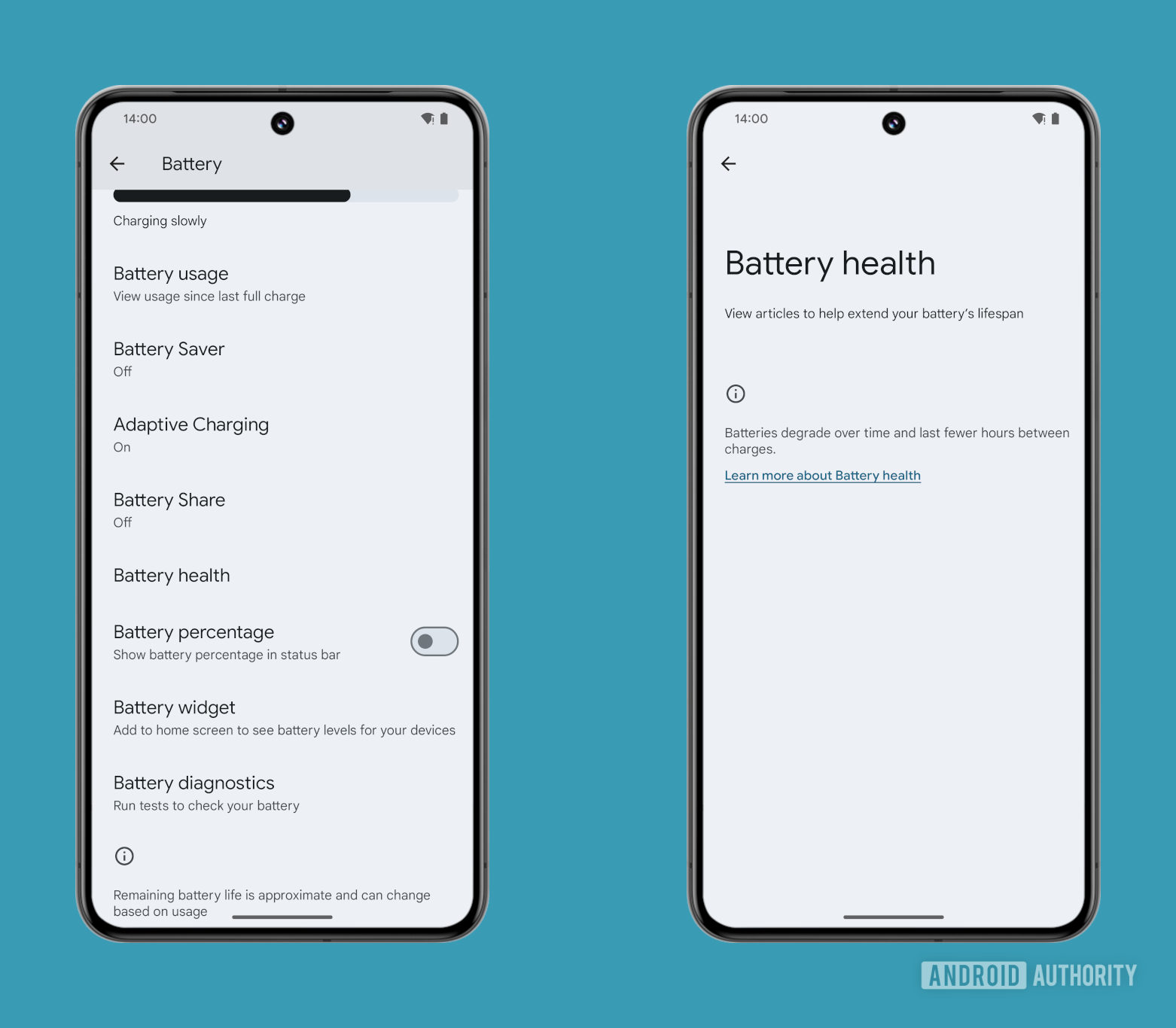
Mishaal Rahman / Android Authority
Android 14 laid the groundwork for the OS to track battery health information, while Android 15 could make battery health information accessible to users. The OS could show the estimated percentage of charge your phone’s battery can currently hold compared to when it was new. This would give users a clearer idea of how far their battery has degraded.
There are a lot of variables involved in this feature coming to light, though we cross our fingers and remain optimistic. iPhones already report their battery health in an easy-to-read manner, and that information has been valuable to users in deciding the condition of pre-owned units and if they should get their battery replaced.
New collapsible volume panel
Android 15’s latest builds feature a new volume panel design. It features much thicker, pill-shaped sliders. A dot is placed at the end where the slider’s maximum value is, and the icons are also tappable to quickly mute that stream.
Android 15’s new volume panel is also collapsible. Tapping the button next to the media volume slider collapses or expands the panel. Whenever there’s active media playback, the volume panel is collapsed by default. Otherwise, it opens in its fully expanded state.
Apart from the new design, the volume panel will also surface additional controls for things like spatial audio and “noise control.”
Powered Off Finding API will let you find devices even when they are switched off
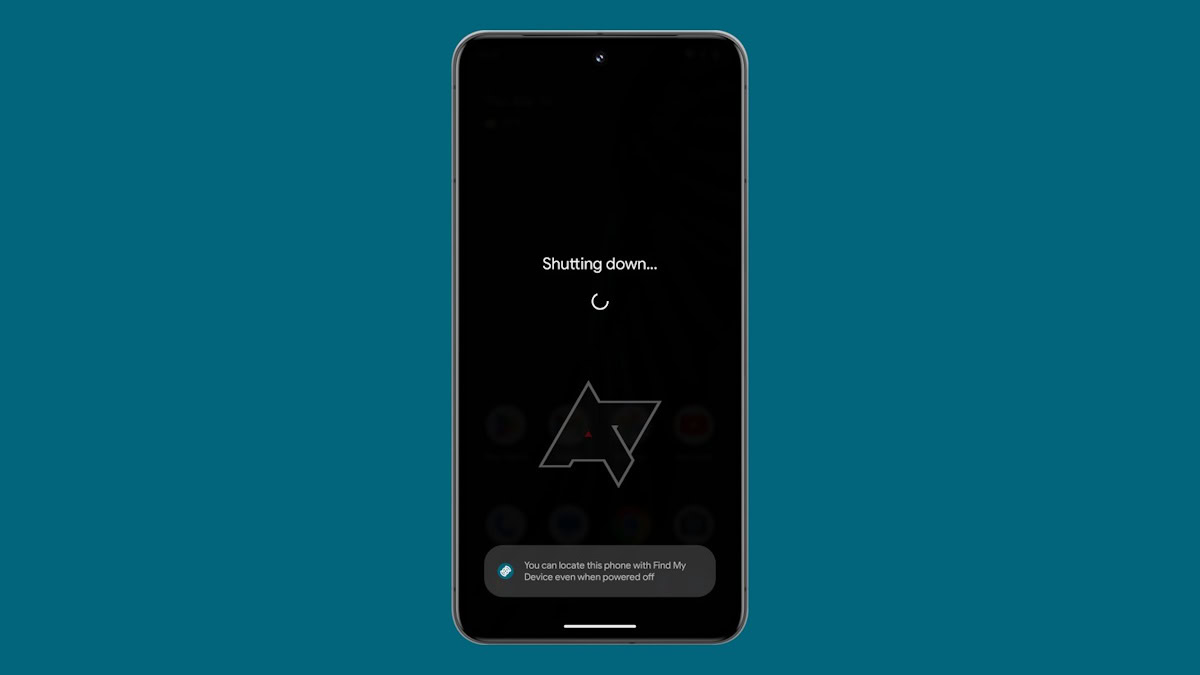
Android 15 will add the new Powered Off Finding API that would enable powered-off finding across compatible Android devices, as per a report. These APIs would be contained within the Project Mainline module called “Tethering,” which can only be used on devices that are running Android 15. Further, this API will be utilized by the upgraded Find My Device network, which will be rolled out through the Google Play Services.
What Powered Off Finding API does is that it allows a device to fire off precomputed Bluetooth beacons, even when the device is off (presuming there is some reserve power available for this action). With these Bluetooth beacons, nearby Android devices will be able to help track the switched-off device, similar to how iPhones can be tracked when they are powered off.
This feature would need hardware support to allow the Bluetooth controller to work when the rest of the device is powered off. The feature also requires the phone to support the Bluetooth Finder HAL so that Android can enable Powered Off Finding mode.
The feature is expected to debut with the Google Pixel 9, but it could also make its way to the Pixel 8 series as the devices include the necessary hardware.
Voice activation feature for digital assistants
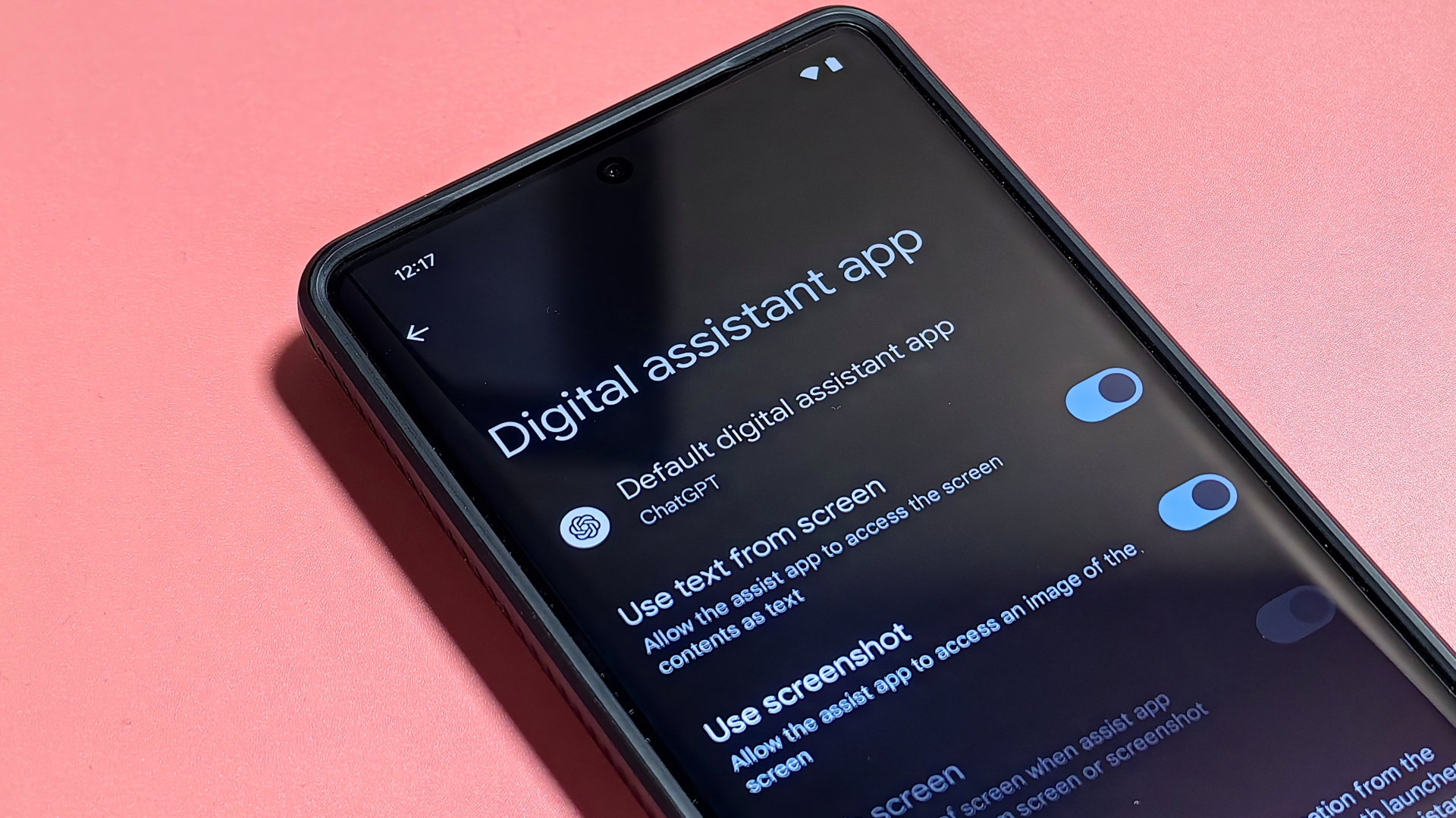
Mishaal Rahman / Android Authority
_cuva
Android allows any app to become the default assistant app on your device, but it doesn’t let them use wake words like “Hey Google” in the background. Your phone would have to constantly listen to audio through the microphone in order to pick up the designated wake word.
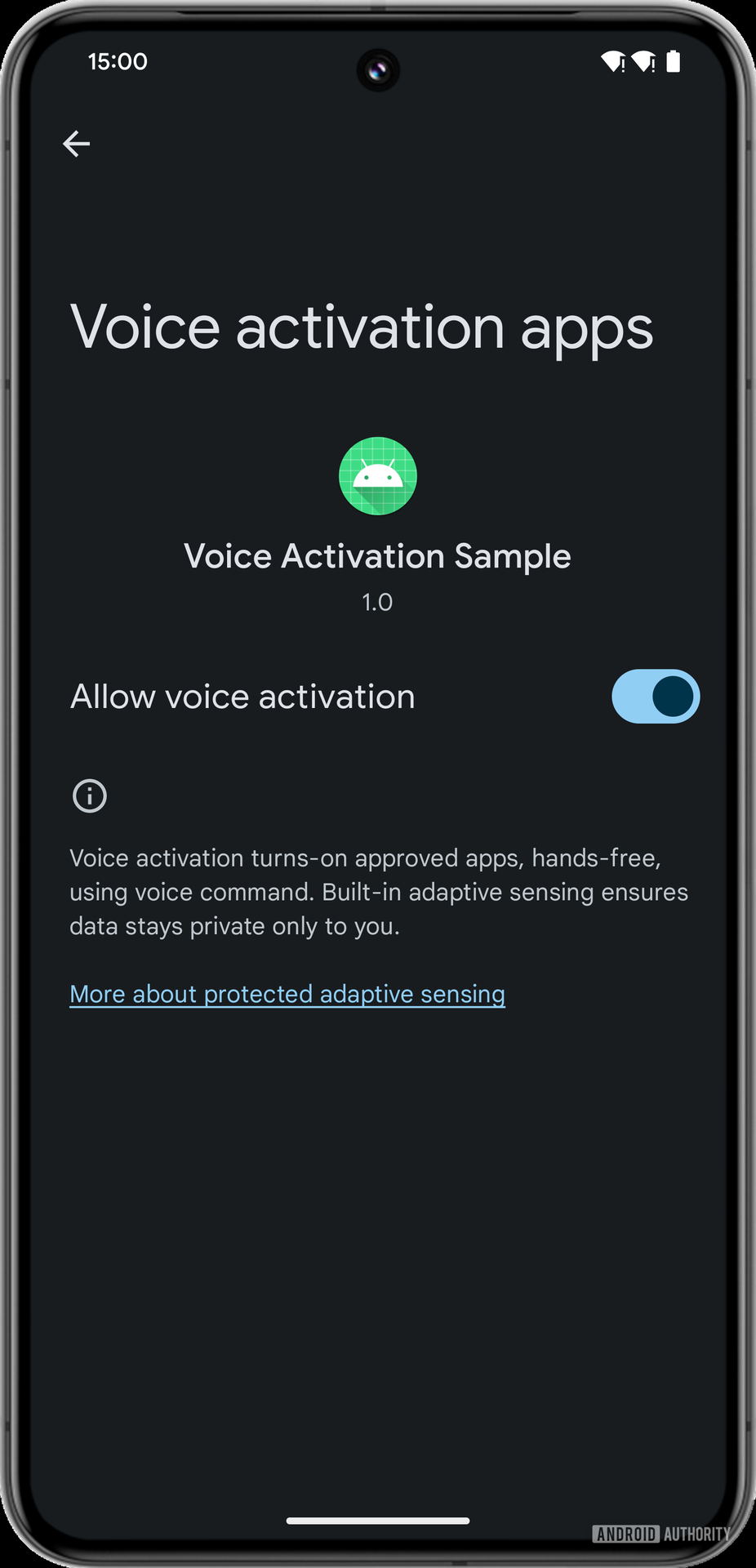
Mishaal Rahman / Android Authority
No apps currently request the voice activation permission, so we had to create a simple app to request it in order to produce the above screenshot.
Previous versions of Android allowed wake word detection, but Google removed the feature with Android 12. This upcoming feature could bring back the functionality, letting apps like ChatGPT and Amazon Alexa become accessible with a wake word, even when your phone’s screen is off. Pre-Android 15, only Google Assistant and Bixby on Samsung phones allow for hands-free voice activation through a wake word.
Private Space
When the feature will go live, it will be available at Settings > Security & privacy > Private Space.
App Pairs to quickly launch split-screen app combos
Android allows you to run apps in split-screen mode, but you have to choose the apps every time you launch them. Android 15 could let you save split-screen app combinations as an App Pair, so you can quickly relaunch a pair of apps into split-screen mode.
When you save an app pair, an icon is added to the home screen that shows the two apps in a saved pair configuration. Clicking on this icon will launch this app pair configuration.
Edge-to-edge apps by default
Android allows apps to use the entire height and width of the display to showcase their content, but many apps do not take advantage of this. Android 15 could force apps to go edge-to-edge by default, though there is a chance that Google gives app developers some more time to adapt their apps.
Easy pre-set mode to improve readability and ease of navigation
Strings within past Android builds indicate that Google has been working on a feature called “easy pre-set mode,” which could arrive with Android 15’s later releases.
Easy pre-set mode could optimize the Android experience for improved readability and ease of navigation. It would do so by enlarging icons and text, adding contrast and boldness, and adding navigation buttons to the bottom of the screen. It would also set the current wallpaper to a black color, so you can have an easier time figuring out your icons and icon labels. A feature like this would be very handy for elderly or less tech-savvy users as it would make it easier to use the phone.
New color contrast settings
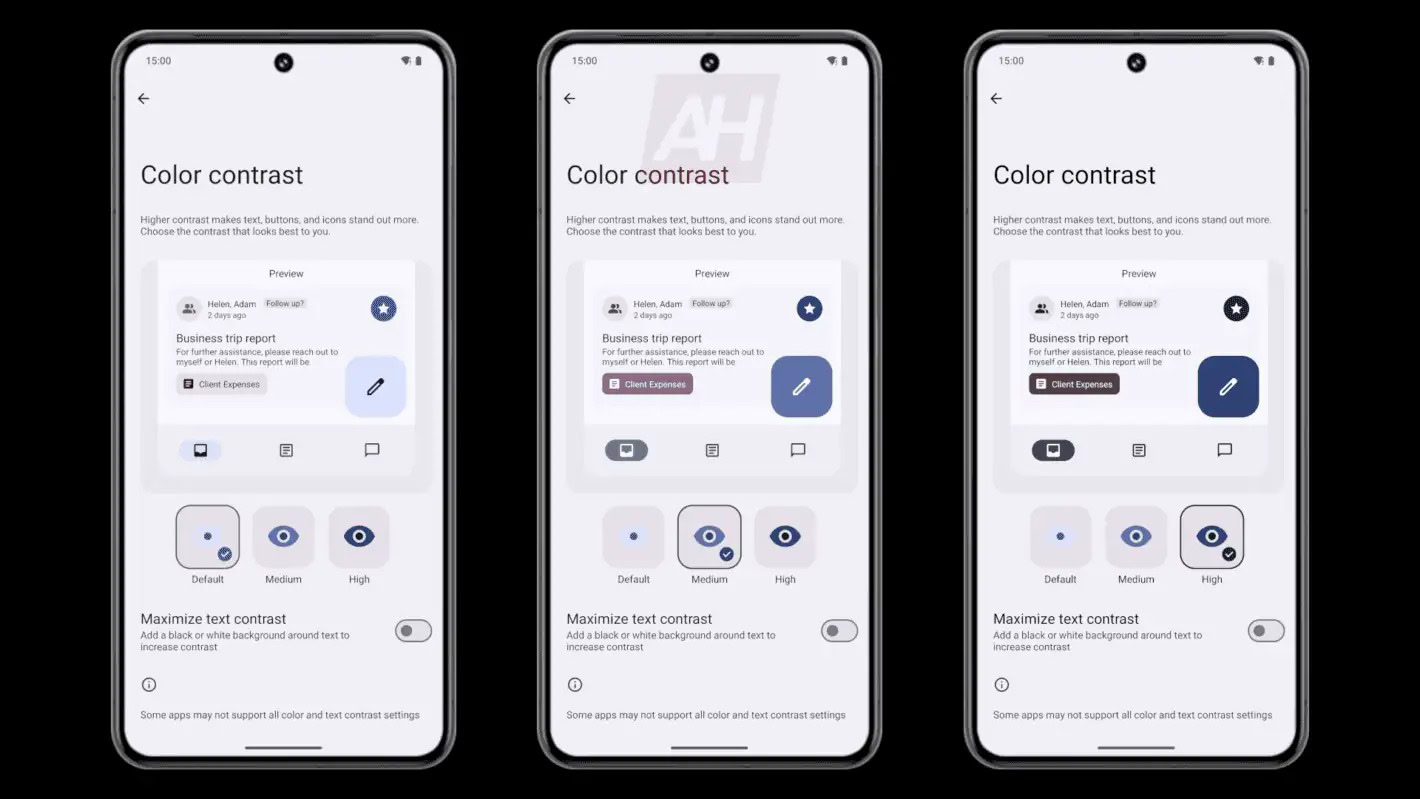
Android 15 has a new “color contrast” settings page that is hidden by default. When manually activated, this page lets the user adjust the contrast of text, buttons, and icons to make them stand out more in apps.
Headphone loud sound alerts
This feature was intended to arrive on Android 14 but arrived with Android 14 QPR 1 (h/t Mishaal Rahman) on Pixel devices. As such, the changes it introduces are expected to be available for the wider Android platform with the Android 15 release.
This new feature monitors sound doses over time to protect users from the damaging effects of excessive or prolonged sound exposure. This feature complies with regulatory requirements in the EU. This feature is also different from the safe media volume limit feature (which focuses on a fixed volume), while the new feature warns when the music is playing loudly (volume measure through the audio signal) for a while.
New Project Mainline module: WebViewBootstrap
Project Mainline is referred to as the biggest change to Android since Project Treble. The purpose of Project Mainline is for Google to wrest control of framework components and system applications that are critical to security and maintaining development consistency away from OEMs, thereby reducing the overall fragmentation in the OS. Project Mainline was introduced with Android 10, and we’ve seen Google add new modules with every Android release.
With Android 15, we will get a new Project Mainline module called WebViewBootstrap. According to a report, this module will handle the core framework APIs that Android uses to integrate WebView into apps. Google already handles the distribution of the core browser component of WebView through the Play Store but pushes the core framework APIs to AOSP for OEMs to pick up from. Switching from AOSP to a Project Mainline module will give Google the ability to update the core framework APIs without OEM intervention.
This new module could launch with Android 15 but could possibly be optional for OEMs to include in their builds. It could be made mandatory to include with Android 16 instead.
New Location Privacy HAL
Android 15 could include a new radio HAL API that allows for location privacy settings. This API will give the user some more control over how their carrier can request a network-initiated location request for non-emergency use cases.
Proactive alerts when using an insecure connection
Android 15 will warn you when a cellular network collects your device’s IMSI or IMEI, as well as when the network attempts to change the ciphering algorithm to create an insecure connection. Your device does need to support newer hardware APIs for this feature to function. The cellular transparency feature will present a notification that informs the user that their device’s IMSI or IMEI has been accessed, and users will be able to access it at Settings > Security & Privacy > More security & privacy. The page will also likely include a toggle to “require encryption,” which will disable null-ciphered connections at the modem level on supported devices.
Android 15 could raise the target SDK version, making older Android Marshmallow apps incompatible
Google introduces new APIs and features with every Android release and banks on developers keeping their apps updated with these new APIs and best practices. However, older apps still exist, and developers may not be keen to keep them updated for various reasons. Regular users still need to be protected against the drawbacks of outdated APIs, so the Google Play Store hides older apps from users. Users could still sideload them, but Android 14 began blocking sideloading apps that were built for Android 6.0 Marshmallow, i.e. with a target SDK version 23.
With Android 15, Google could raise this target SDK version to 24. This means that apps targeting APIs for Android 6.0 Marshmallow will not be easy to install, and you’d need to default to apps built for Android 7.0 Nougat at least.
Android 15: Features we want to see
Android 15 is shaping up to be an influential update, but it’s not perfect. There is plenty that Google could improve, and since there is still time, we hope they consider some of these features to
Android 14 was a relatively iterative update, but everything we’ve seen from previous betas indicates Google is busy working on some bigger changes that will eventually make their way to Android 15. Before we dive into all the rumors, let’s start by taking a look at just a few features I’d love to see come to Android 15 update.
App cloning and/or a secure folder
Some of us have more than one account for select social or work-related apps. While many apps like Instagram, Messenger, and TikTok now have their built-in solutions for these scenarios, there are still many apps out there that don’t allow you to run more than one account without workarounds like fully logging in and out each time. Samsung and several other Android phone makers handle this in a variety of ways. For example, Samsung has a Dual Messenger feature that lets you clone a lot of major social networks, and you can also effectively run two instances using Samsung’s Secure Folder feature.
Android 15 should finally bring an official app cloning tool to Android. I’d like to see something that lets you make endless duplicates that can be placed anywhere on your phone, though it’s more likely we’ll just get our take on Secure Folder. In fact, the rumors already suggest Google is doing just that. The new feature will be called Private Space and will let Android users hide and lock their apps. Likely, you’ll also be able to run multiple instances of the app this way, though we don’t have any specifics on how all this will work.
Widgets could use an overhaul
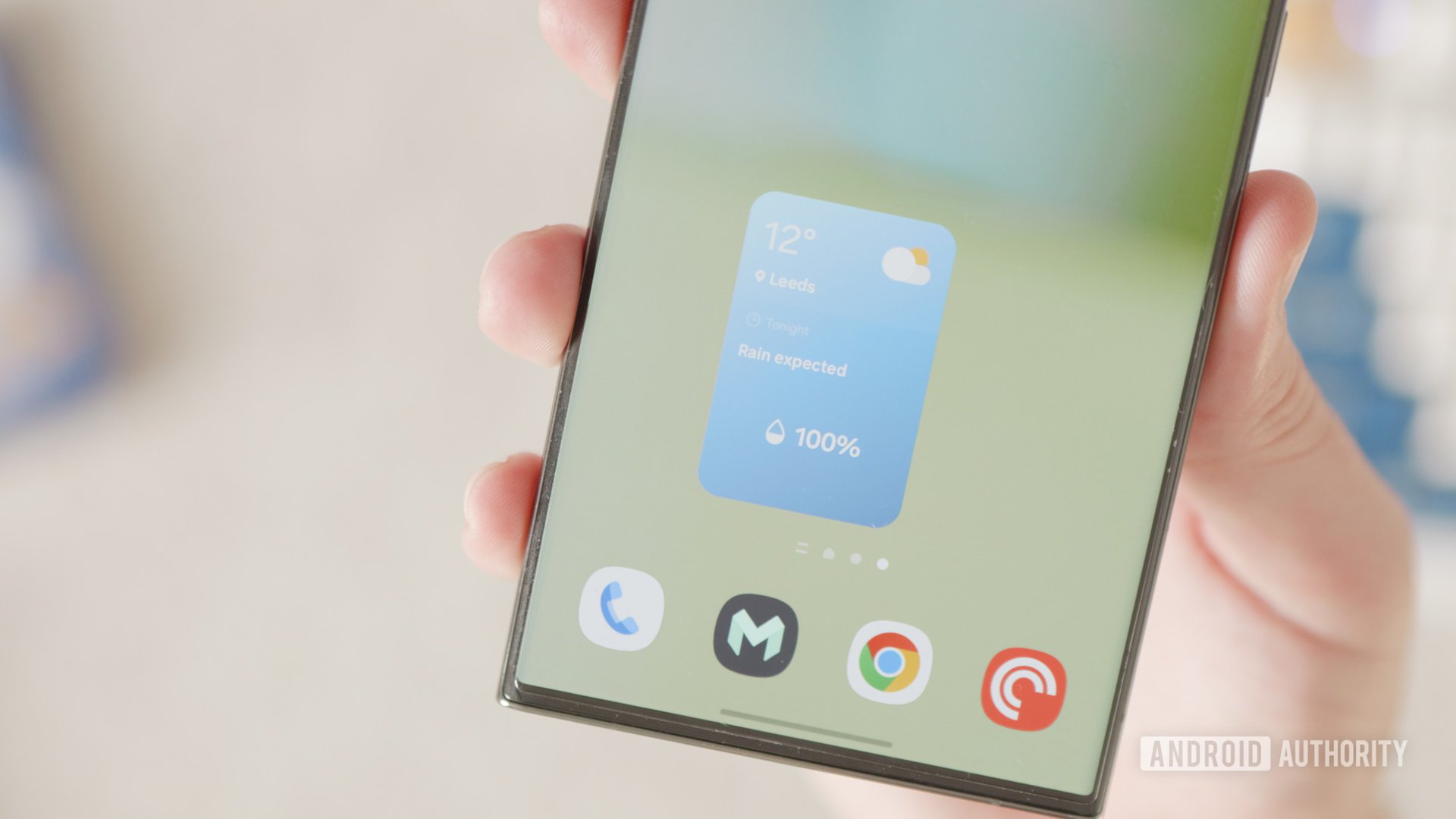
Damien Wilde / Android Authority
It’s time for Android to update the way it handles widgets. Back in the earlier days of Android, you could add widgets to the lock screen, but this feature was removed with Android 5.0 Lollipop. It’s time for this to come back! We always felt they should be an option, but now that Apple has embraced widgets in a big way with iOS, the time is definitely right.
Widgets have evolved a lot recently, and in many ways, Apple is ironically leading the pack right now. This goes for stacked widgets as well. The ability to stack widgets in iOS is a helpful addition, and Android 15 could benefit from this and other widget enhancements if it wants to continue to be the leader in the widget space it created.
How likely is it that Android 15 will make these changes? Code within the Android 14 QPR2 beta suggests that lock screen widgets may soon be a thing, though there have yet to be any leaks or code suggesting stacked widgets are part of this plan.
Floating Windows
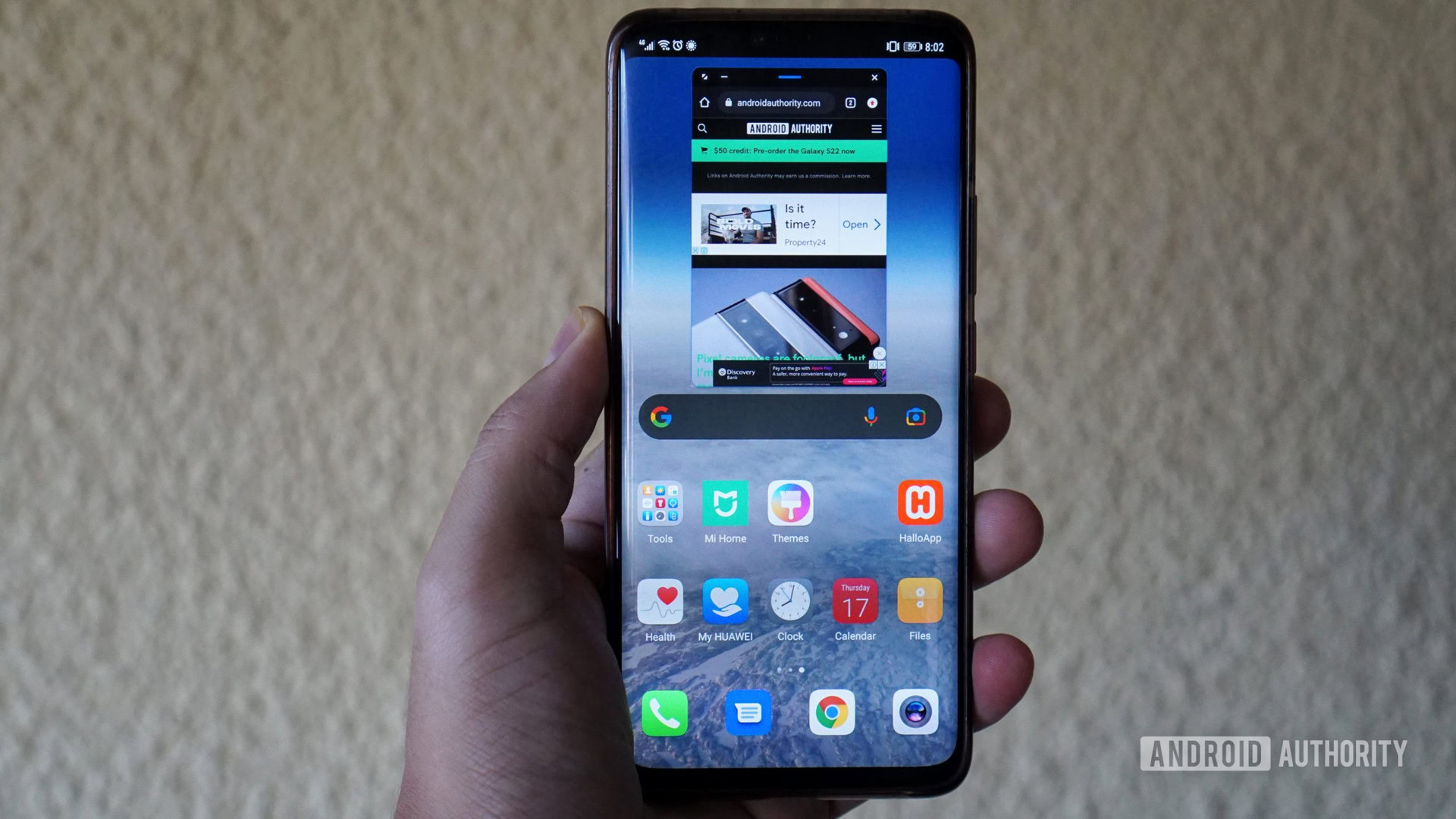
Hadlee Simons / Android Authority
Floating widgets aren’t as common in many of the most mainstream Android skins these days, but I’ve found the feature pretty useful when I’ve encountered them on skins like ColorOS and MIUI. In short, these skins let you resize any app so it fits on the screen without taking up the entire width of the display. You can even overlay apps onto other ones, which can come in handy. For example, you’re planning groceries for the week but need to keep using the calculator to add up totals. Keeping the calculator as a floating window makes it easy for you to grab and use at any time.
Is this a must-have feature many will care about? Probably not, but sometimes even the smallest additions can prove to be truly useful, even if only for some of us.
Further customization options, especially for icons
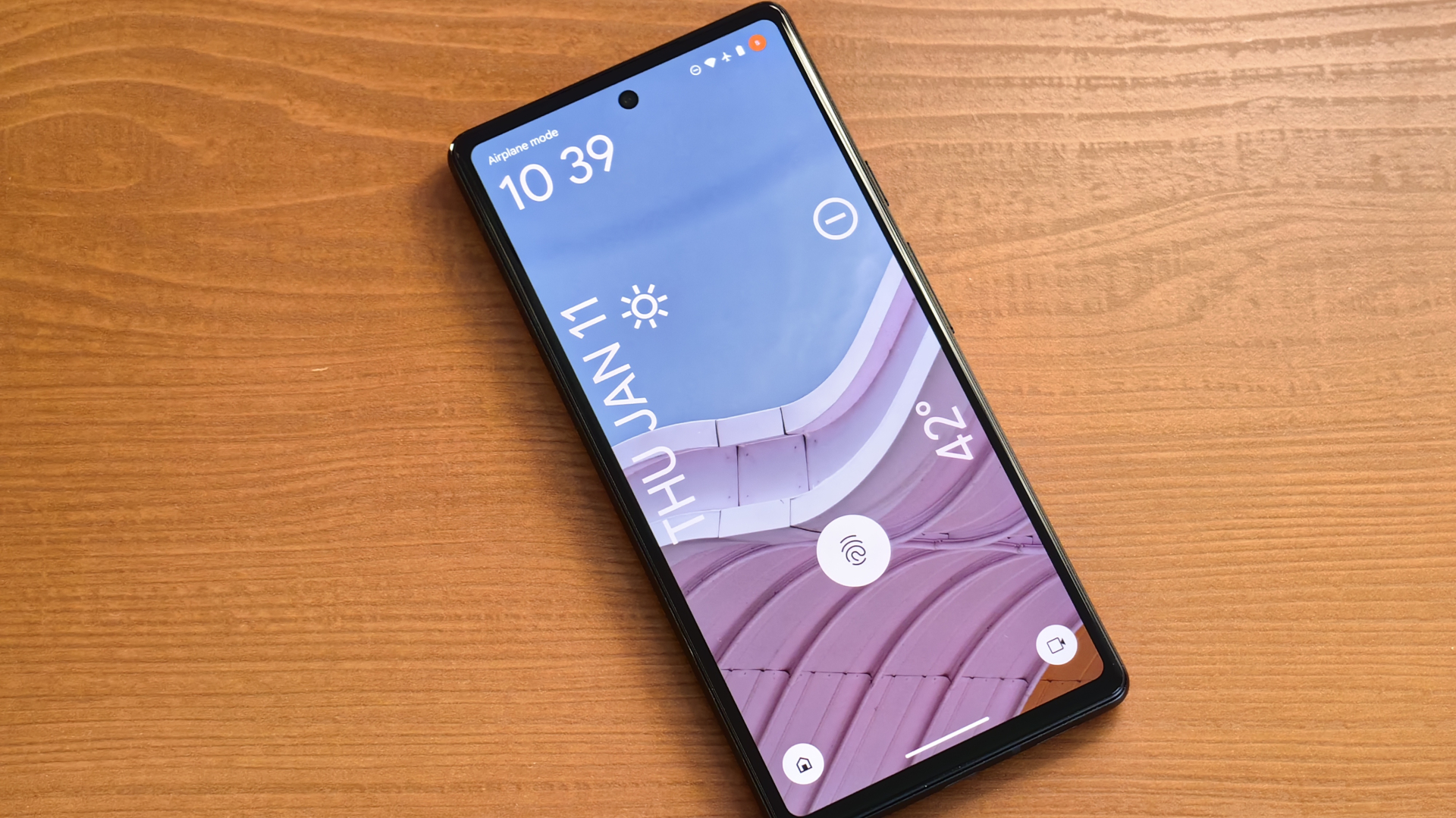
Mishaal Rahman / Android Authority
Google has pushed customizability a lot in recent Android iterations, but I feel there’s room to go even further, especially when it comes to icons.
Android 12 introduced themed icons as a beta feature, but many app makers ignored the feature, so applying themes tends to create a garbled mess of inconsistent icons. Google needs to address this either by partnering with more app makers or by simply creating better tools that can take icons for apps that ignore this feature and force them into Google’s style, perhaps using some kind of generative AI. It’s certainly possible.
It’s not just about the theming, though. I’d like to see icons get more customizations for shapes, fonts, and even the style of icons presented in the Quick Menu. Android used to allow this, but its changes in Android 12 removed this for better consistency with its new theming system. Irony, anyone?
While we’re talking about customizations, I’d also like to see the Quick Menu get some love. While you can already do a fair amount with Quick Settings, I’d like to see more granular controls, such as combining shortcuts into one function. Let’s say you have a routine consisting of a few different shortcuts; this would allow you to trigger them all at once. On a related note, I’d also like the option to control some things separately that are combined, like Wi-Fi and Mobile Networks. I hated when Google merged these under one roof, and I know I’m far from the only one.

